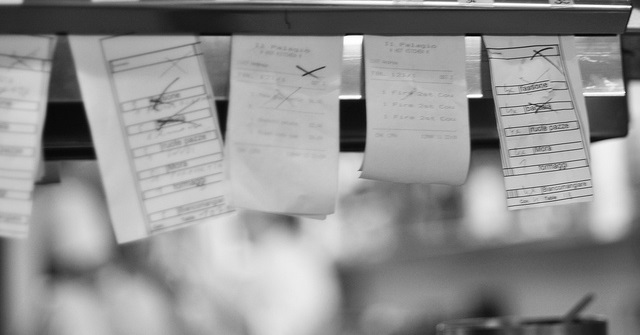Most kitchens still use the term “Fire” to signify that it’s safe to begin cooking food for a particular table. The covert operations involved in successfully delivering your food at that magical moment when every member of your party is ready are much more complicated than you think. When you take an unexpected smoke break between courses or stop eating to go off on an hourlong tangent about being raised by your alcoholic stepfather, you put the kitchen and waitstaff in precarious limbo.
In most restaurants, one of these three different approaches usually govern the firing of food:
1) Manual Entry – The waiter has a “FIRE” key on the computer system and will use it to indicate to the Chef that the table is ready. This method can be unreliable when the server gets weeded and is unable to properly communicate a table’s readiness to the kitchen.
2) Scouting – The kitchen will send a food runner to “scout” a table to determine whether it is safe to fire. Most kitchens base their decisions on whether or not to fire on feedback from FOH informants. This is the most common method in a majority of casual to upscale restaurants. Too often, the scout will be overly optimistic in his prediction of readiness, especially when there is pressure from the Chef to push food out of the kitchen to make way for new orders. It is not out of the ordinary for food to arrive prematurely despite this feedback loop.
3) Auto Pilot – High volume restaurants often fire food on a fixed time schedule. A busy kitchen with orders pilling up doesn’t have the luxury of accomodating every table’s individual pace. In this case, for example, a table’s entrees will be fired 10-15 minutes after their appetizers have left the kitchen. Menus with multiple courses or prix fixe may have a set firing schedule with specific times assigned to each course. In these high volume environments, you’d be wise to down your Jalapeño Poppers within a reasonable amount of time unless you want your main course to be served on top of it.
In an ideal world, you will never notice the gears in motion. In good restaurants, FOH and BOH will work in concert to ensure the arrival of each course of food will be seamless. The times you do notice, though, will most likely be when your food arrives too slowly. Sometimes that happens because the staff is unable to accurately project when you will be finished. Picking and nibbling at shared appetizers for example can cause unnecessary delays in the later courses. Restaurant kitchens are not in the business of throwing away food that was fired too soon, so they will usually err on the side of caution. You can help alleviate some of the stress by being mindful of how much time you are taking to finish each course. Delicious food isn’t conjured by magic. There are people working—usually in extreme conditions—to prepare it for you. Show respect to the chefs who cook your food by eating responsibly.

